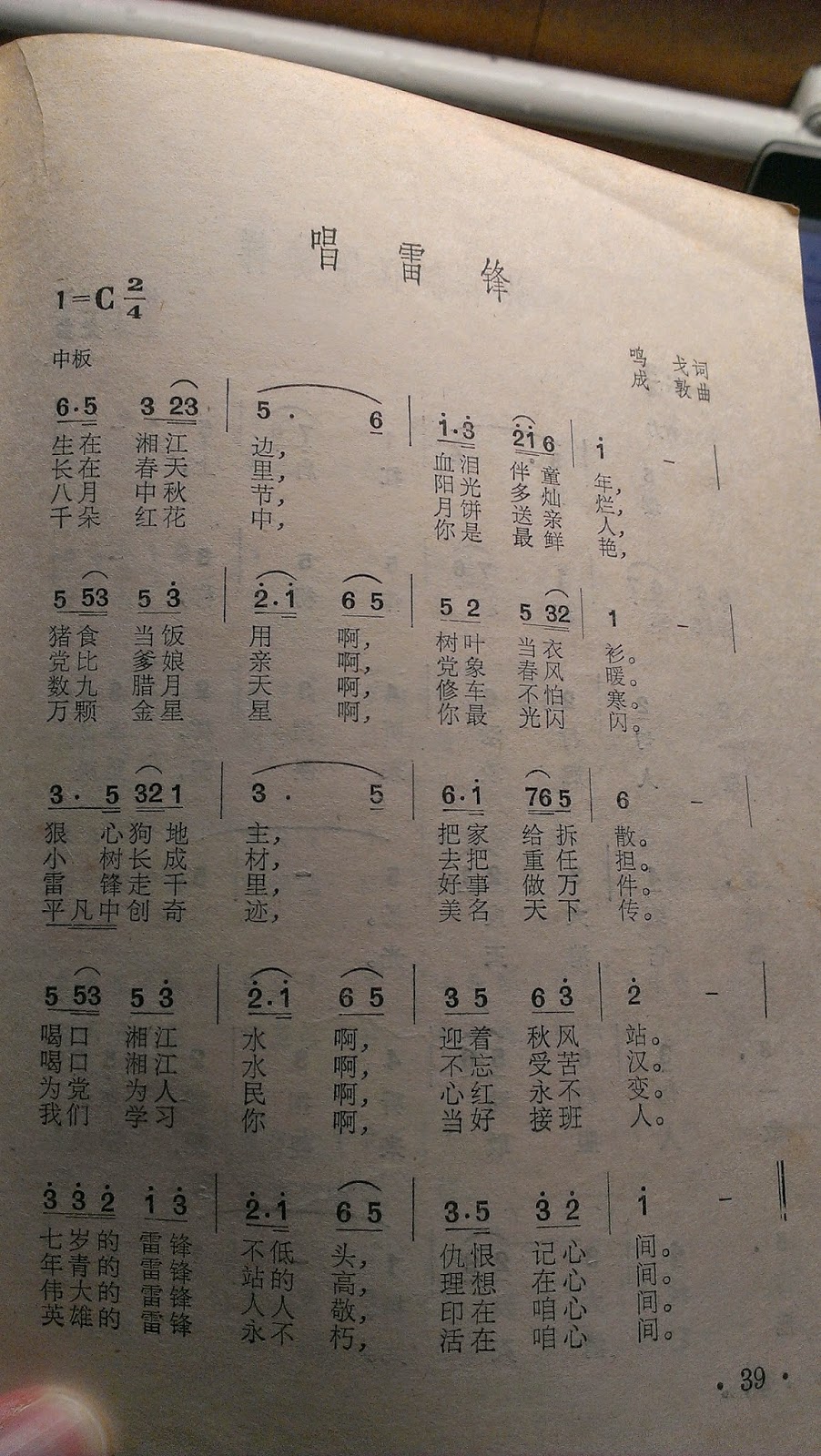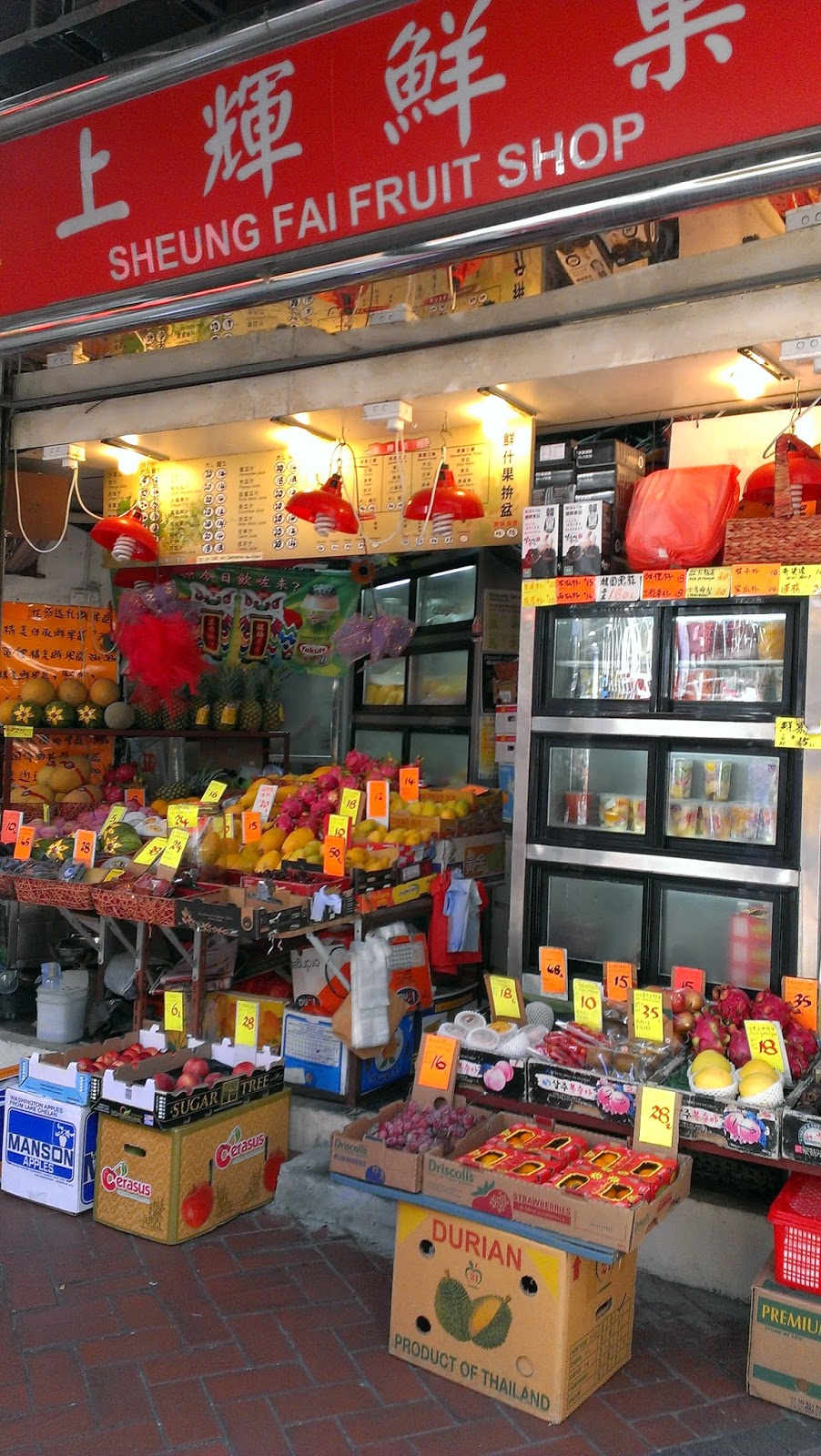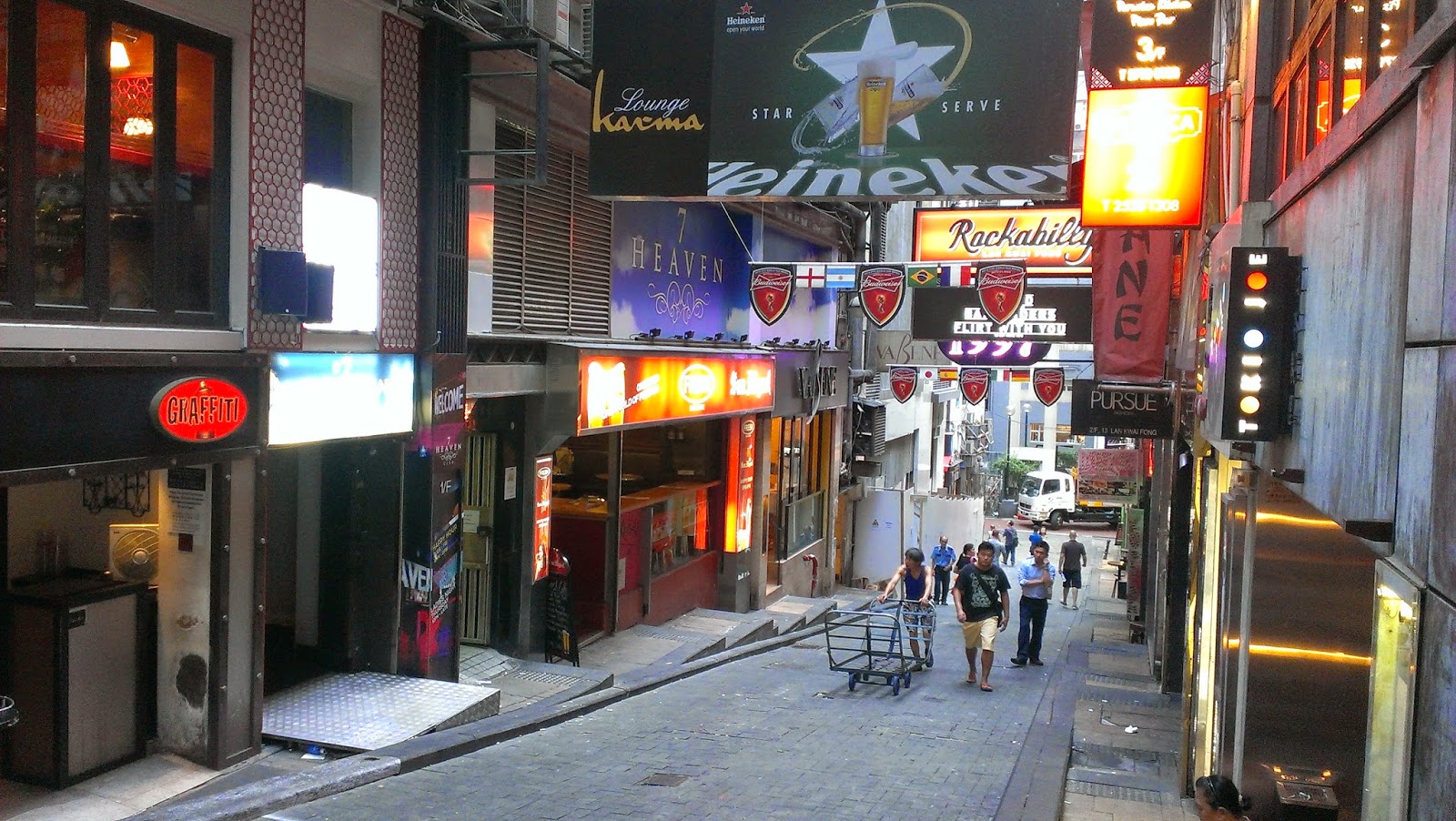All around Wong Tai Sin, there were many eating places lying around and it was around noon so I decided to look around.
Here is a street stall filled with such snacks as curry fish balls and noodles:
The one that I went to, Chuen Sing cha caan teng (泉成茶餐廳), is located just a short walk east on a major road from Wong Tai Sin:
As is typical for a cha caan teng, some bakery items are displayed for sale at the store window
Here is the menu of the Chuen Sing, all in Chinese. It's a good thing I know how to read Chinese because (as I later found out from talking with one of the waiters) the restaurant did not have any English menus at all. In fact, it seemed like the entire restaurant was filled with Hong Kong locals enjoying a Saturday lunch - no tourists whatsoever.
In the end, I decided to order a Beef Ball Soup Hor Fun Noodles (牛丸河粉) with a cold Lemon Tea. An interesting thing to note is that the Chinese character for "noodles" here is 粉 which means that the noodles are made of rice flour (the radical 米 "rice" hints at the meaning). The other type of "noodles" is 麵 which are made of wheat flour (again, the radical 麥 "wheat" hints at the meaning).
Compared to the hor fun I was used to back in Canada, the hor fun I had at Chuen Sing was firmer in texture and tended not to soak up the soup and become soggy. As for the vegetables and the beef balls, I couldn't really detect anything different.
Afterwards, I took the MTR to Cheung Sha Wan Station to browse for some second-hand books.
Even after so many years, this area of Hong Kong still looks like it must have seemed back in the 80s:
Thanks to Google Maps, I quickly found my way to the bookstore - San Tin Bookstore (新天書業).
Located inside the bookstore is an absolute treasure trove of second-hand books, with a vast collection ranging from self-help books in English to history texts in Chinese. The owner of the bookstore even keeps a cat, who seems to prowl around the bookstore on whim.
Here is a shot of the different books that I bought at the bookstore (the total for all 6 books was only $180 HKD or $26 CAD):
Of these six books, only items (1) and (6) have any interesting historical value. The 1971 World Today magazine, for instance, has an optimistic article entitled 《南越海軍的成長》 "The maturing of the South Vietnam Navy". The Vietnam War would end with the total annexation of the South Vietnamese state by North Vietnam just four years later.
On the other hand, the "280 Songs for Youths and Children" is interesting because it tells the story of the Cold War from the other side (if we simplify the Cold War into two sides). The first edition was published in 1979 while this copy (third edition) was published in 1982 which means that it was written around the time of China's opening up to the world. This is why you can find staunchly Communist songs such as 紅領巾 "Red Neckerchief" (referring to the red neckerchiefs of the Young Pioneers youth group of Communist China) and 唱雷鋒 "Sing of Lei Feng" (referring to the man held as a "model Communist" for all Chinese in the People's Republic of China) and yet still find songs from NATO-aligned countries like the United States, Australia, Norway, England, France, West Germany, and Japan.
Eventually, my phone ran out of battery, so I decided to take photos of my next destinations on Google Maps, which I accessed on the free Internet stations in Central Station.
Next, I'm off to try some but jai gou (sugar pudding in a bowl) which is popular in Hong Kong as a street snack. I decided to try them at one of the more famous but jai gou vendors, "Super Bowl King Traditional Snack" (砵仔王) at Sheung Wan (上環). However, in spite of the photo I took earlier of Super Bowl King's Google Map location, I still got lost. Here are some pictures that I took of Sheung Wan in the afternoon as I wandered around:

I also happened to bump into the famous Western Market:
Eventually however, I found my way to 砵仔王.
Of course, 砵仔王 doesn't just sell but jai gou but other Chinese snacks as well. Here is a sign at the shop advertising how they also stock "The Three Treasures of Guangdong Province": Preserved Orange Peel (陳皮), Aged Ginger (老薑), and Hay (禾稈草).
The but jai gou are stored in small porcelain bowls (in Chinese, 砵) in a box at the store; the store attendant takes two wooden skewers, sticks them through the but jai gou, extracts them from the bowl, and then wraps the pudding in a plastic wrap:
As I ate the but jai gou, I took this photo of people crossing the street near the shop:
When I was an elementary school student back in Canada (equivalent to Primary 1 / 小一 through Form 2 / 初二 in the Hong Kong education system), my father often bought but jai gou from the local bakery for me to eat once school had ended. On first glance, the but jai gou is certainly larger (and heavier) than I am used to - around a 20-30% than I'm used to. Also, the but jai gou back in Canada were completely wrapped in plastic wrap and did not use toothpicks. But when I first bit into the Hong Kong but jai gou, I immediately realized that this was the real deal. The first thing I noticed was that the but jai gou was hot (around body temperature) instead of room temperature, as I'm used to. Also, the pudding was much softer to the bite. Instead of the firm texture I'm used to, this but jai gou had a texture that was almost fluffy (for lack of better words) to the bite and you could taste the aroma of the brown sugar in the pudding.
After that, I went to Central Station on my way to Chinese Arts & Crafts and decided to make a detour to the partying district of Hong Kong - Lan Kwai Fong (蘭桂坊).
As I walked to Lan Kwai Fong, the streets were filled with high-class boutiques:
I almost missed the entrance to Lan Kwai Fong, because the sign to it was placed on a plain white construction wall.
Lan Kwai Fong is famed amongst Western expatriates in Hong Kong for its many pubs, bars, and clubs. None of this interests me, so I only went to take pictures. I half expected drunken partying in the bars but it was still Happy Hour so the area was very calm and quiet.
I walked over to Chinese Arts and Crafts (中藝華夏) which was described as a Chinese department store, so I expected something similar to Yue Hwa (裕華) department store which I visited on Nathan Road some weeks ago.
But Chinese Arts and Crafts was completely different. Instead of catering to the average Hong Kong citizen, it seemed to target the super-rich of Hong Kong (and perhaps Mainland Chinese tourists). In fact, I thought I had stepped into a jewelry store at first. The staff wear suits and open the doors for you. Bright lights illuminate glass cases of Chinese antiques, ranging from jade ornaments to wooden Buddhist statues. There were even works of calligraphy by a niece of the last Chinese Emperor Puyi (溥儀), who works as a calligraphy artist for Chinese Arts and Crafts. The price ranges were extraordinarily high - even the most ordinary piece of calligraphy was around $800 HKD ($115 CAD). The beautiful silk embroidered "paintings" which shimmer when you walk around them and highlight different features in bright detail were possibly the most expensive items - the most expensive was around $300,000 HKD ($43,000 CAD)! While I walked around, I made sure not to even come close to any of these products lest I lose all my savings from a broken product. Even the polo shirts and woolen sweaters were expensive - around $800-1000 HKD ($115-150 CAD). I wanted to take pictures, but remembered that some high-class boutiques in Hong Kong did not allow pictures so I'll leave you with these written descriptions of the shop.
Afterwards, I headed over to a Cafe de Coral for a dinner of Soy Sauce and Pepper Beef on Rice (豉椒牛柳飯) with their special summer drink - Red bean milk and shaved ice (粒粒紅豆冰). By this time, the restaurant was already filled, so I had to share a table with some other customers (hence the cane in the top-left corner).
As I made my way back to Central Station, I took some pictures of a street marketplace:
This time, I arrived at Causeway Bay Station (銅鑼灣) and on my way to Kung Wo Tong (恭和堂) for some traditional Chinese desserts, I made a detour to Times Square (時代廣場):
This is roughly the spot where I stood with my father and an elementary old schoolmate from Hong Kong as we counted down on New Years 2009 nearly six years ago. Then, Hong Kong was a fascinating and bewildering place - never before had I been to such a place where so many Chinese culture was so concentrated and pervasive. Although I grew up in an area of Canada where Chinese people were the predominant ethnic group, Chinese culture and language had always played an unofficial and secondary role to the dominant lingua franca of English. Six years ago, I had only started to teach myself to read and write Chinese so Chinese was all incomprehensible text to me.
Now, after six years of self-study of Chinese in Canada, I had finally progressed to the level of being able to read almost all the Chinese characters in everyday use. Hong Kong no longer felt like an extreme version of the Chinese subculture in Canada, but more and more like the original version of the Chinese community in Canada. Hong Kong was no longer strange and exciting to me, but familiar and homely.
After some more wandering around (Google Maps doesn't provide exact locations in Hong Kong, apparently), I found Kung Wo Tong, which is famed for its traditional Chinese desserts and herbal teas - the most famous of which is its guilinggao (龜苓膏 "Tortoise Shell Pudding") which is made from the ground shell of a certain species of turtle.
In the end, I ordered a cold guilinggao for $48 HKD. The menu (completely in Chinese again) notes that the benefits of eating guilinggao include nourishing of yin, clearing of poison (in the traditional Chinese sense), and cooling of the qi (which is traditionally seen as important during the hot summer months).

The orange jug in the right of this picture contains sugar syrup for the guilinggao. When the guilinggao arrived, I scooped up some of it, put it in the bowl provided, added a bit of syrup, and tasted it. It was very bitter but had a certain herbal taste to it. Although I could have added more syrup to cover over the bitterness, that would mask the taste of the guilinggao. In fact, I eventually gained a taste for guilinggao, since it's best enjoyed not for any obvious sweet taste but its subtle fragrance amid the bitter taste. 
Near the entrance are two portraits of Qing government officials - Kung Wo Tong has an old history dating back to the Qing Dynasty. 
Time to go back to HKUST now, but first some inspirational poems written in Chinese and (broken) English and posted by the mini-bus stop at Hang Hau Station.
I haven't decided where to go next week yet, so see you next time!































































No comments:
Post a Comment